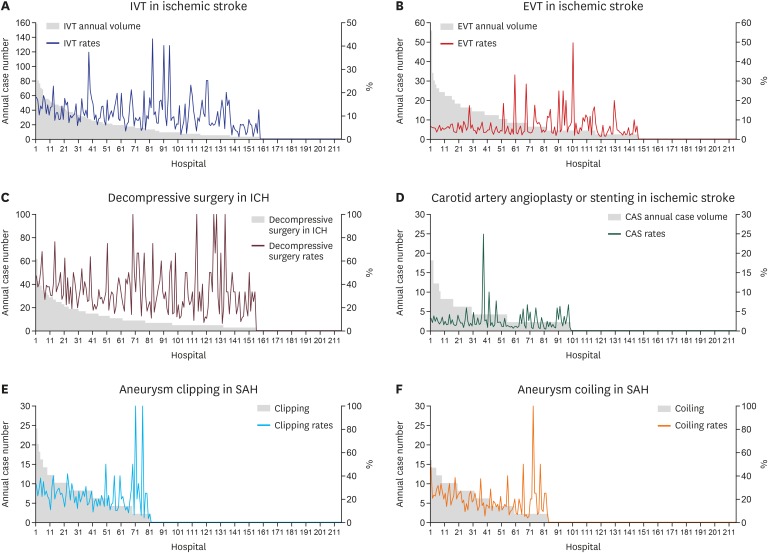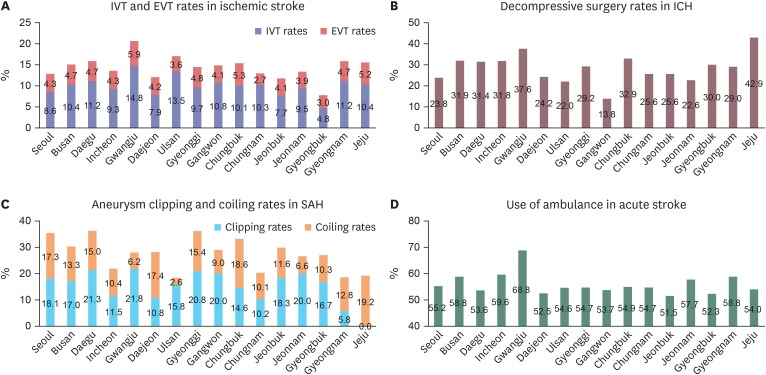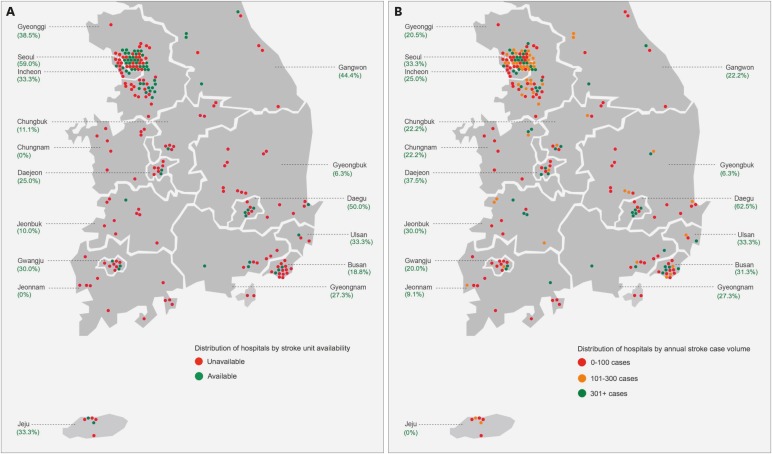Acute Stroke Care in Korea in 2013–2014: National Averages and Disparities
- Affiliations
-
- 1Department of Neurology, Seoul National University Bundang Hospital, Seoul National University College of Medicine, Seongnam, Korea
- 2Department of Neurology, Inje University Ilsan Paik Hospital, Goyang, Korea
- 3Department of Neurology, Nowon Eulji Medical Center, Eulji University, Seoul, Korea
- 4Department of Neurology, Chung-Ang University Hospital, Chung-Ang University College of Medicine, Seoul, Korea
- 5Department of Neurology, Soonchunhyang University Hospital, Soonchunhyang University College of Medicine, Seoul, Korea
- 6Department of Neurology, Eulji University Hospital, Eulji University College of Medicine, Daejeon, Korea
- 7Department of Neurosurgery, Seoul National University Bundang Hospital, Seoul National University College of Medicine, Seongnam, Korea
- 8Clinical Research Center, Asan Institute for Life Sciences, Asan Medical Center, Seoul, Korea
- 9Department of Biostatistics, Korea University College of Medicine, Seoul, Korea
- 10Health Insurance Review and Assessment Service, Wonju, Korea
- KMID: 2500848
- DOI: http://doi.org/10.3346/jkms.2020.35.e167
Abstract
- Background
This study aimed to describe the current status of acute stroke care in Korea and explore disparities among hospitals and regions.
Methods
The 2013 and 2014 national stroke audit data and the national health insurance claims data were linked and used for this study. Stroke patients hospitalized via emergency rooms within 7 days of stroke onset were selected.
Results
A total of 19,608 patients treated in 216 hospitals were analyzed. Among them 76% had ischemic stroke; 15%, intracerebral hemorrhage (ICH); and 9%, subarachnoid hemorrhage (SAH). Of the hospitals, 31% provided inpatient stroke unit care. Ambulances were used in 56% of cases, and the median interval from onset to arrival was 4.5 hours. One-quarter of patients were referred from other hospitals. Intravenous thrombolysis (IVT) and endovascular treatment (EVT) rates were 11% and 4%, respectively. Three-quarters of the analyzed hospitals provided IVT and/or EVT, whereas 47% of hospitals providing IVT and 67% of hospitals providing EVT had less than one case per month. Decompressive surgery was performed on 28% of ICH patients, and clipping and coiling were performed in 17.2% and 14.3% of SAH patients, respectively. There were noticeable regional disparities between the various interventions, ambulance use, arrival time, and stroke unit availability.
Conclusion
This study describes the current status of acute stroke care in Korea. Despite quite acceptable quality of stroke care, it suggests regional and hospital disparities. Expansion of stroke units, stroke center certification or accreditation, and connections between stroke centers and emergency medical services are highly recommended.
Figure
Cited by 4 articles
-
Routing to Endovascular Treatment of Ischemic Stroke in Korea: Recognition of Need for Process Improvement
Jihoon Kang, Seong-Eun Kim, Hong-Kyun Park, Yong-Jin Cho, Jun Yup Kim, Keon-Joo Lee, Jong-Moo Park, Kwang-Yeol Park, Kyung Bok Lee, Soo Joo Lee, Ji Sung Lee, Juneyoung Lee, Ki Hwa Yang, Ah Rum Choi, Mi Yeon Kang, Nack-Cheon Choi, Philip B. Gorelick, Hee-Joon Bae
J Korean Med Sci. 2020;35(41):e347. doi: 10.3346/jkms.2020.35.e347.Comparative Analysis of the Patients with Spontaneous Thalamic Hemorrhage with Concurrent Intraventricular Hemorrhage and Those without Intraventricular Hemorrhage
Taek Min Nam, Ji Hwan Jang, Seung Hwan Kim, Kyu Hong Kim, Young Zoon Kim
J Korean Med Sci. 2020;36(1):e4. doi: 10.3346/jkms.2021.36.e4.Effect of Transport Time on the Use of Reperfusion Therapy for Patients with Acute Ischemic Stroke in Korea
Jay Chol Choi, Joong-Goo Kim, Chul-Hoo Kang, Hee-Joon Bae, Jihoon Kang, Soo-Joo Lee, Jong-Moo Park, Tai Hwan Park, Yong-Jin Cho, Kyung Bok Lee, Jun Lee, Dong-Eog Kim, Jae-Kwan Cha, Joon-Tae Kim, Byung-Chul Lee, Ji-Sung Lee, Anthony S. Kim
J Korean Med Sci. 2021;36(11):e77. doi: 10.3346/jkms.2021.36.e77.Annual Case Volume and One-Year Mortality for Endovascular Treatment in Acute Ischemic Stroke
Jun Yup Kim, Jihoon Kang, Beom Joon Kim, Seong-Eun Kim, Do Yeon Kim, Keon-Joo Lee, Hong-Kyun Park, Yong-Jin Cho, Jong-Moo Park, Kyung Bok Lee, Jae-Kwan Cha, Ji Sung Lee, Juneyoung Lee, Ki Hwa Yang, Ock Ran Hong, Ji Hyeon Shin, Jung Hyun Park, Philip B. Gorelick, Hee-Joon Bae
J Korean Med Sci. 2022;37(36):e270. doi: 10.3346/jkms.2022.37.e270.
Reference
-
1. Coffeen L. “If you can't measure it, you can't manage it.” -Peter Drucker. Updated 2009. Accessed January 23, 2020. https://blog.marketculture.com/2009/03/20/if-you-cant-measure-it-you-cant-manage-it-peter-drucker.2. King's College London for the Stroke Alliance for Europe. The burden of stroke in Europe. Updated 2017. Accessed January 23, 2020. http://strokeeurope.eu.3. National Stroke Foundation. National stroke audit: acute services report 2015. Updated 2015. Accessed January 23, 2020. https://informme.org.au/-/media/A3039E82D9FF4BC7803B5C67B42DBBB0.ashx?la=en.4. Fonarow GC, Reeves MJ, Smith EE, Saver JL, Zhao X, Olson DW, et al. Characteristics, performance measures, and in-hospital outcomes of the first one million stroke and transient ischemic attack admissions in get with the guidelines-stroke. Circ Cardiovasc Qual Outcomes. 2010; 3(3):291–302. PMID: 20177051.
Article5. Hsieh FI, Lien LM, Chen ST, Bai CH, Sun MC, Tseng HP, et al. Get with the guidelines-stroke performance indicators: surveillance of stroke care in the Taiwan stroke registry: get with the guidelines-stroke in Taiwan. Circulation. 2010; 122(11):1116–1123. PMID: 20805428.6. Wilkins EW, Wickramasinghe K, Bhatnagar P, Leal J, Luengo-Fernandez R, Burns R, et al. European Cardiovascular Disease Statistics 2017. Brussels: European Heart Network;2017.7. Benjamin EJ, Virani SS, Callaway CW, Chamberlain AM, Chang AR, Cheng S, et al. Heart disease and stroke statistics-2018 update: a report from the American Heart Association. Circulation. 2018; 137(12):e67–492. PMID: 29386200.
Article8. Jang MU, Kang J, Kim BJ, Hong JH, Yeo MJ, Han MK, et al. In-hospital and post-discharge recovery after acute ischemic stroke: a nationwide multicenter stroke registry-base study. J Korean Med Sci. 2019; 34(36):e240. PMID: 31538419.
Article9. Lee KB, Lee JG, Kim BJ, Kim JY, Lee KJ, Han MK, et al. The epidemiology of fracture in patients with acute ischemic stroke in Korea. J Korean Med Sci. 2019; 34(22):e164. PMID: 31172697.10. Giroud M, Lemesle M, Quantin C, Vourch M, Becker F, Milan C, et al. A hospital-based and a population-based stroke registry yield different results: the experience in Dijon, France. Neuroepidemiology. 1997; 16(1):15–21. PMID: 8994936.
Article11. Appelros P, Högerås N, Terént A. Case ascertainment in stroke studies: the risk of selection bias. Acta Neurol Scand. 2003; 107(2):145–149. PMID: 12580866.
Article12. Park HK, Kim SE, Cho YJ, Kim JY, Oh H, Kim BJ, et al. Quality of acute stroke care in Korea (2008–2014): retrospective analysis of the nationwide and nonselective data for quality of acute stroke care. Eur Stroke J. 2019; 4(4):337–346. PMID: 31903432.
Article13. The Joint Commission. Primary stroke centers. Updated 2017. Accessed January 23, 2020. https://www.jointcommission.org/certification/dsc_neuro2.aspx.14. Feigin VL, Lawes CM, Bennett DA, Barker-Collo SL, Parag V. Worldwide stroke incidence and early case fatality reported in 56 population-based studies: a systematic review. Lancet Neurol. 2009; 8(4):355–369. PMID: 19233729.
Article15. Wang WZ, Jiang B, Wu SP, Hong Z, Yang QD, Sander JW, et al. Change in stroke incidence from a population-based intervention trial in three urban communities in China. Neuroepidemiology. 2007; 28(3):155–161. PMID: 17536227.
Article16. Toyoda K. Epidemiology and registry studies of stroke in Japan. J Stroke. 2013; 15(1):21–26. PMID: 24324936.
Article17. Willeit J, Geley T, Schöch J, Rinner H, Tür A, Kreuzer H, et al. Thrombolysis and clinical outcome in patients with stroke after implementation of the Tyrol stroke pathway: a retrospective observational study. Lancet Neurol. 2015; 14(1):48–56. PMID: 25435129.
Article18. Smith EE, Saver JL, Cox M, Liang L, Matsouaka R, Xian Y, et al. Increase in endovascular therapy in get with the guidelines-stroke after the publication of pivotal trials. Circulation. 2017; 136(24):2303–2310. PMID: 28982689.
Article19. Riksstroke Swedish Stroke Register. Brief summary of riksstroke data for the full year 2017. Updated 2017. Accessed January 23, 2020. http://www.riksstroke.org/annual-reports-and-graphs.20. Dumont TM, Rughani AI. National trends in carotid artery revascularization surgery. J Neurosurg. 2012; 116(6):1251–1257. PMID: 22482791.
Article21. Witt AH, Johnsen SP, Jensen LP, Hansen AK, Hundborg HH, Andersen G. Reducing delay of carotid endarterectomy in acute ischemic stroke patients: a nationwide initiative. Stroke. 2013; 44(3):686–690. PMID: 23422089.22. Qureshi AI, Suri MF, Nasar A, Kirmani JF, Ezzeddine MA, Divani AA, et al. Changes in cost and outcome among US patients with stroke hospitalized in 1990 to 1991 and those hospitalized in 2000 to 2001. Stroke. 2007; 38(7):2180–2184. PMID: 17525400.
Article23. Langham J, Reeves BC, Lindsay KW, van der Meulen JH, Kirkpatrick PJ, Gholkar AR, et al. Variation in outcome after subarachnoid hemorrhage: a study of neurosurgical units in UK and Ireland. Stroke. 2009; 40(1):111–118. PMID: 19008474.24. Inagawa T, Shibukawa M, Inokuchi F, Tokuda Y, Okada Y, Okada K. Primary intracerebral and aneurysmal subarachnoid hemorrhage in Izumo City, Japan. Part II: management and surgical outcome. J Neurosurg. 2000; 93(6):967–975. PMID: 11117869.
Article25. Aguiar de Sousa D, von Martial R, Abilleira S, Gattringer T, Kobayashi A, Gallofré M, et al. Access to and delivery of acute ischaemic stroke treatments: a survey of national scientific societies and stroke experts in 44 European countries. Eur Stroke J. 2019; 4(1):13–28. PMID: 31165091.
Article26. The Joint Commission. Certification data download of stroke certification. Updated 2019. Accessed June 18, 2019. http://www.qualitycheck.org/data-download/certification-data-download.27. Royal College of Physicians. Mind the gap! The third SSNAP annual report. Care received between April 2015 to March 2016. Updated 2017. Accessed June 18, 2019. https://www.strokeaudit.org/Documents/National/Clinical/AugNov2016/AugNov2016-PublicReport.aspx.28. Wiedmann S, Heuschmann PU, Hillmann S, Busse O, Wiethölter H, Walter GM, et al. The quality of acute stroke care- an analysis of evidence-based indicators in 260 000 patients. Dtsch Arztebl Int. 2014; 111(45):759–765. PMID: 25467052.29. Weber R, Eyding J, Kitzrow M, Bartig D, Weimar C, Hacke W, et al. Distribution and evolution of acute interventional ischemic stroke treatment in Germany from 2010 to 2016. Neurol Res Pract. 2019; 1(1):4.
Article30. Rinaldo L, Brinjikji W, Rabinstein AA. Transfer to high-volume centers associated with reduced mortality after endovascular treatment of acute stroke. Stroke. 2017; 48(5):1316–1321. PMID: 28336679.
Article31. Adamczyk P, Attenello F, Wen G, He S, Russin J, Sanossian N, et al. Mechanical thrombectomy in acute stroke: utilization variances and impact of procedural volume on inpatient mortality. J Stroke Cerebrovasc Dis. 2013; 22(8):1263–1269. PMID: 23017430.
Article32. Bray BD, Campbell J, Cloud GC, Hoffman A, Tyrrell PJ, Wolfe CD, et al. Bigger, faster? Associations between hospital thrombolysis volume and speed of thrombolysis administration in acute ischemic stroke. Stroke. 2013; 44(11):3129–3135. PMID: 24052511.
- Full Text Links
- Actions
-
Cited
- CITED
-
- Close
- Share
- Similar articles
-
- Organization of Stroke Care System: Stroke Unit and Stroke Center
- Mortality and Disparities of Acute Myocardial Infarction and Stroke in Korea, 2008–2019
- Development of Patient Classification System based on Nursing Intensity in Stroke Unit
- Primary and Comprehensive Stroke Centers: History, Value and Certification Criteria
- Pneumococcal meningitis complicated by otomastoiditis and pneumocephalus confounding an acute ischemic stroke diagnosis




